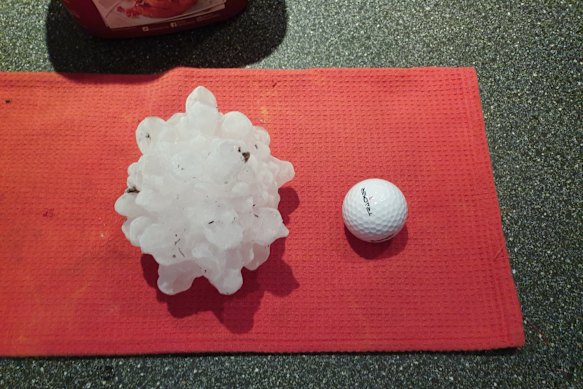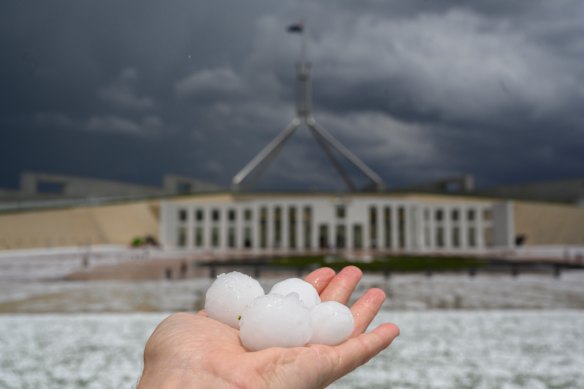Brace yourself for ‘giant hail’ as storms increase along east coast
Hailstorms will become more frequent in Brisbane, Sydney and Canberra, and the size of the stones that the storms create will grow in Canberra, Sydney, Melbourne and Perth as the climate warms over coming years, new modelling shows.
With every degree the atmosphere warms, it can hold 7 per cent more moisture, creating more turbulent conditions and increasing the likelihood of damaging hailstorms, said Dr Tim Raupach, author of a paper on projected hail damage in major Australian cities.

A record 13-centimetre hailstone hit Boronia Heights on the outskirts of Brisbane in 2020.Credit: Niel Gentile
His modelling compared the historical incidence of hailstorms over the cities, with conditions expected in a scenario where the climate warms by 2.4 degrees by 2080.
The result was that while there may be more hailstorms in Brisbane, the chances of “giant hail” being produced became far higher in Sydney, Canberra, Melbourne and Perth.
“In the historical scenario, Melbourne would be expected to see a 100-millimetre hailstone – 10 centimetres – every 20 years, but in the future scenario, it would be expected to see one every three years,” said Raupach, whose paper was published in the journal Geophysical Research Letters.

Golf ball-sized hail hits Parliament House in Canberra in 2020.Credit: Getty Images
In Sydney and Canberra, as the atmosphere warmed, the chances of giant hail hitting the cities increased from every three years to every two years.
For Perth, the chances of a hail producing day creating giant hail are predicted to increase from around 14 per cent to around 21 per cent. In Kalgoorlie, the study projects that 10 centimetres of hail could fall every six years rather than every 18 in current conditions.
Raupach, a researcher in atmospheric science at the UNSW Climate Change Research Centre, said the purpose of the study was to compare the two atmospheric eras to explore the potential impact of climate on hail.
“If we had all the computing power in the world, we’d run multiple simulations,” he said.
Hailstorms need a handful of key ingredients to develop, said Raupach, including instability in the atmosphere that gives rise to updrafts – in which hailstones form and grow, adding new layers of frozen moisture as they tumble through the storm – as well as windshear, which is a significant difference in horizontal winds at different levels of the atmosphere.
“What we saw in Brisbane was an increase in instability, but a decrease in wind shear. And so I think those two are offsetting.
“In Sydney, Canberra and Melbourne, we saw increases in both instability and wind shear, which increases the ability of the storms to create larger stones.”

Many homes and vehicles in Berowra Heights sustained damage in December 2018. Studies show hailstones are getting bigger. Credit: Wolter Peeters
The frequency of hailstorms was projected to increase by 29 per cent in Canberra and Sydney and 15 per cent in Brisbane, modelling showed, while maximum hailstone size would increase by 7.8 millimetres around Melbourne and 3.9 millimetres around Sydney and Canberra.
Hailstorms are already one of the costliest natural disasters to hit Australian cities and were responsible for more than 20 per cent of insured losses in Australia from 1967 to 2023. The 1999 Sydney hailstorm, caused $1.7 billion in insured losses when it hit the city with cricket-ball sized hailstones. It would have resulted in an estimated $8.85 billion in insured losses if it had happened in 2023, according to an estimate by the Insurance Council of Australia.
Raupach said any storm with hail over two centimetres in size could be destructive, with forces associated with stones larger than five or 10 centimetres “increasing massively”.
“If we want to avoid this sort of damage a good place to start would be reducing carbon emissions,” he said.
Get to the heart of what’s happening with climate change and the environment. Sign up for our fortnightly Environment newsletter.